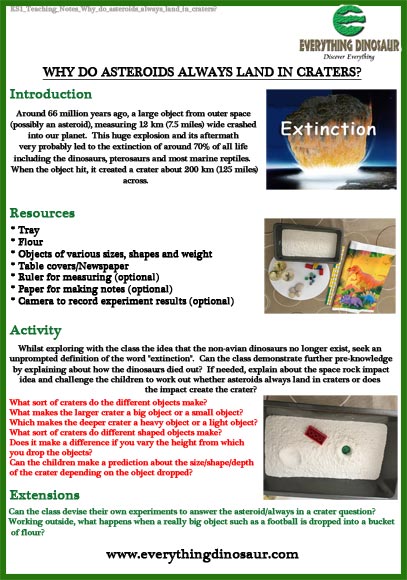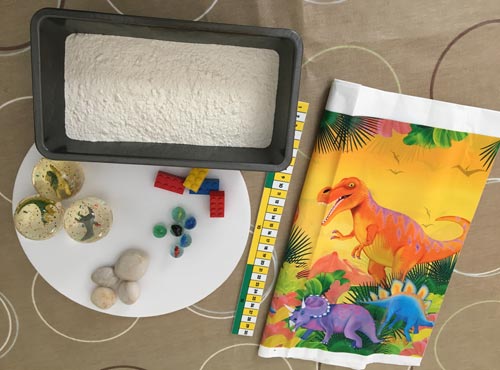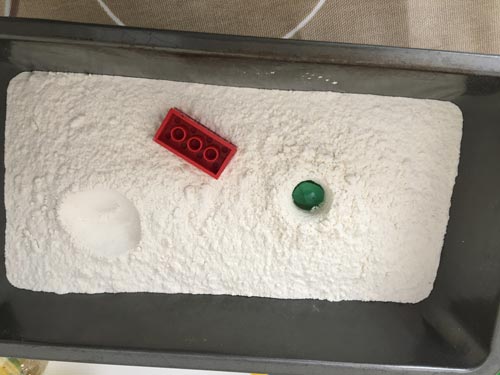Why Do Asteroids Always Land in Craters? That’s a Great Lesson Plan Idea
Why Do Asteroids Always Land in Craters? A Lesson Plan
Team members at Everything Dinosaur have been busy preparing another lesson plan idea linked to the concept of “working scientifically” when it comes to delivering teaching outcomes related to the science elements of the national curriculum for England. The lesson is aimed at both Key Stage 1 and Key Stage 2 students and asks the question “Why do asteroids always land in craters”?
The Lesson Plan with Teaching Notes for Key Stage 1

Picture credit: Everything Dinosaur
Linking to the Dinosaur Extinction Event as well as Space Modules
The dinosaur extinction is linked to a large impact event, in this lesson plan our aim is to encourage the children to work scientifically, experience and observe phenomena, devise and complete simple comparative tests, communicate ideas, observe closely and to use simple equipment to find answers. This lesson plan relates to both the “dinosaurs” and the “space” term topic. It should also help young minds to explore everyday materials and describe the simple physical properties of those materials.
One of the factors involved in the extinction event at the end of the Age of Dinosaurs involved an extra-terrestrial object crashing into our planet, so teachers can tie in extinction and the causes of extinction to an extension activity involving the class having to work scientifically to explore what happens when objects fall to Earth.
Two types of lesson plans have been developed, the lesson plan with accompanying teaching notes aimed at Upper Key Stage 2 deals with issues such as animals and their habitats, natural selection, evolution and introduces the idea of the force of gravity.
Essentially, to test this idea of asteroids always landing in craters, the children would have to develop an experiment whereby they drop objects into a substrate and record what happens.
Suggested Resources to be Used to Test the Hypothesis

Picture credit: Everything Dinosaur
Suggested Resources for the Key Stage 1 Lesson Plan
Here is a list of typical resources suggested to test the idea of asteroids always landing in craters with a Key Stage 1 class. Essentially, the children need to consider a suitable substrate and to test what happens when objects are dropped into the substrate.
* Tray
* Flour or sand (substrate)
* Objects of various sizes, shapes and weight
* Table covers/newspaper
* Ruler for measuring (optional)
* Paper for making notes (optional)
* Camera to record experiment results (optional)
For dinosaur themed toys and games: Dinosaur Toys and Gifts.
Outlining the Lesson with the Class
Whilst exploring with the class the idea that the non-avian dinosaurs no longer exist, seek an unprompted definition of the word “extinction”. Can the class demonstrate further pre-knowledge by explaining about how the dinosaurs died out? If needed, explain about the space rock impact idea and challenge the children to work out whether asteroids always land in craters or does the impact create the crater?
Can the Children Create Simple Comparative Tests?

Picture credit: Everything Dinosaur
Visit the award-winning Everything Dinosaur website: Everything Dinosaur.
Extension Ideas – Questions to Ask
What sort of craters do the different objects make?
What makes the larger crater a big object or a small object?
Which makes the deeper crater a heavy object or a light object?
What sort of craters do different shaped objects make?
Does it make a difference if you vary the height from which you drop the objects?
Can the children make a prediction about the size/shape/depth of the crater depending on the object dropped?
In addition, the Key Stage 2 lesson plan and teaching notes asks the class to devise their own experiments to answer the asteroid/always in a crater question.
As a “wow” moment to conclude the lesson plan, try this idea. Working outside, what happens when a really big object such as a football is dropped into a bucket of flour? The spraying of flour should provide a suitable memorable moment to help the class remember the key learning points from this simple experiment.
For further advice and ideas about science teaching in school, simply email our team members at Everything Dinosaur: Email Everything Dinosaur.

